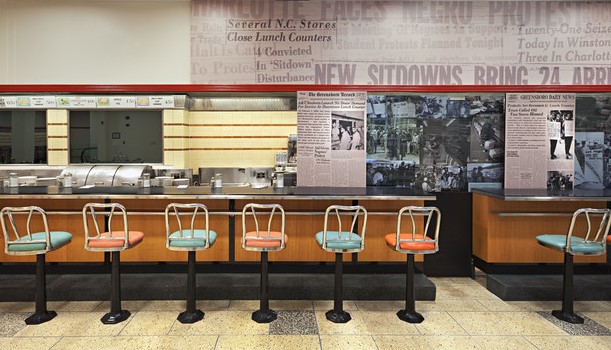Located at 134 S. Elm Street in Greensboro, North Carolina, the International Civil Rights Center and Museum (ICRCM) opened its doors on February 1, 2010. This date marks exactly fifty years after four African-American university students bravely initiated a sit-in at a “Whites Only” lunch counter at F.W. Woolworth in downtown Greensboro. Their act of non-violent defiance was the catalyst for the sit-in movement in the United States.
It is apropos that the ICRCM would be housed in the same building where these valiant young men, known as “The Greensboro Four”, began their non-violent protest. Ezell Blair, Jr. (now known as Jibreel Khazan), Franklin McCain, Joseph McNeil and David Richmond matriculated North Carolina Agricultural and Technical State University. Peacefully challenging the major department store’s policy of refusing service to non-White patrons, the number of students grew exponentially. This protest proved to be a watershed moment in the Civil Rights Movement.
This Woolworth store, which had been founded in 1939, closed in 1993; the chain closed all its doors in 1997. Because of its historical significance, activists and citizens began to lobby to prevent the former store from being razed. These persons include local radio personality, Dr. Michael Lynn, who broadcasted his show every morning in front of the closed building. A petition was created and it garnered almost twenty-thousand signatures.
Guilford County Commissioner Melvin “Skip” Alston and Greensboro City Councilman Earl Jones suggested that the property be purchased and converted into a museum. The two collaborated to form the non-profit organization, Sit-In Movement, Inc., which successfully bought and renovated the former Woolworth building. In 2001, the organization partnered with North Carolina A&T and worked to develop the International Civil Rights Center & Museum.
Occupying thirty-thousand square feet, the new International Civil Rights Center & Museum was designed by the Freelon Group of Durham, North Carolina. Its exhibits include a re-enactment of the planning session of the “Greensboro Four” in their dorm room at North Carolina A&T and the recreation of the famous lunch counter sit-in. The exhibits, designed by Eisterhold Associates of Kansas City, Missouri, are held on the main floor and offices are held on the top floor.
The ICRCM is centered upon and dedicated to the global attainment of civil and human rights. The vision of the center and museum involves honoring the Greensboro Four and the non-violent protests and actions that followed, activating many to become involved in the Civil Rights Movement. It is the hope of those at ICRCM that the historic sit-ins at the F.W. Woolworth counter will continue to encourage and strengthen others to assist in the liberation of those who are oppressed.
The mission of the International Civil Rights Center & Museum is, according to its website, “to ensure that the world never forgets the courage displayed by four young North Carolina A&T State College students, on February 1, 1960, and the hundreds and thousands of college and community youth in Greensboro, in the South and around the country who joined them in the days and weeks that followed which led to the desegregation of the Woolworth lunch counter and ultimately to the smashing of the despicable segregation system in the southern United States. The ICRCM seeks to preserve the legacy and the significance of that event by demonstrating why, in the current context, such inherently evil, institutionalized oppression has no place in the human race. The International Civil Rights Center & Museum exists as a testimony to courage and the potential of unified people on the right side of history to make change. The ICRCM will be a gift from the citizens of North Carolina to the nation and the world. We build this monument for their benefit.”
At the ribbon-cutting ceremony of the International Civil Rights Center & Museum were the three surviving members of the “Greensboro Four”. Franklin McCain, Joseph McNeil and Jibreel Khazan were the guests of honor. Speakers at the event included U.S. Assistant Attorney Thomas Perez, who represented President Barack H. Obama; U.S. Senator Kay Ruthven Hagan (D) and Governor Beverly Perdue (D) of North Carolina.
In promoting its message for equality, freedom and justice, the ICRCM houses a permanent installation, The Battlegrounds. It also contains a gallery that features temporary exhibitions as well as educational and interactive exhibits. Guests may view original photographs, videos and artifacts such as a pen used to sign the Voting Rights Act of 1965 and formal attire of a Ku Klux Klan member. Onsite is also an auditorium, classrooms and the Joint Center for the Study of Human Rights. In 2007, the ICRCM launched the Black and White Ball, which has since become an annual event.
The Center & Museum has created their own awards to honor the outstanding work and contributions of those involved with advancing civil rights. These honors include the “Trailblazer Award”, “Unsung Hero Award”, “Sit-in Participant Award” and “Alston-Jones International Civil and Human Rights Award”, the highest award gifted by the ICRM. Recipients of this most prestigious honor include poet, author, activist and Maya Angelou and anthropologist, university president and museum director, Dr. Johnetta B. Cole.
While the International Civil Rights Center & Museum does charge admission fees, its operations are also supported by private donations from individuals and foundations. It also received support from the City of Greensboro, Guilford County, the State of North Carolina and the U.S. Department of the Interior.
Amenities at the ICRCM include offsite parking and access to wireless internet. Handicap accessible, guided tours are available to guests.
